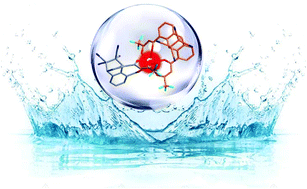Designing water-quenching resistant highly luminescent europium complexes by regulating the orthogonal arrangement of bis-β-diketone ligands†
Abstract
Luminescent β-diketone-based lanthanide complexes have been well explored as chemical sensor materials for biomedicine applications. Herein, three mononuclear Eu3+ complexes based on bis-β-diketone ligands (L1, L2 and L3) that can reduce luminescence quenching caused by water were developed. The ligands feature two β-diketone units covalently bound at the 1,8-position of the derivatized anthracene (modified with tetracyanoethylene, TCNE). X-ray crystallographic analysis reveals that their self-assemblies with Ln3+ ions in a 2 : 1 stoichiometric ratio form mononuclear anion complexes, [EuL2]−, in which two ligands coordinate to the metal center in a mutually orthogonal manner. This kind of arrangement together with the bulge of TCNE from the anthracene plane well protected the complexes from the quenching effects of water molecules in the second coordination. The photophysical measurements showed that the complexes not only had high luminescence quantum yields (QYs, up to 50–67%) but also presented excellent water-quenching resistant capability.



 Please wait while we load your content...
Please wait while we load your content...